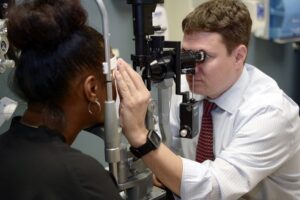
In 2018, Seth Holst, MD, an ophthalmologist conducted an eye exam at the VA Pittsburgh Healthcare System. Glaucoma is a leading cause of blindness at the VA. —VA photo
HOUSTON — How does a history of gout or arthritis due to hyperuricemia affect the development of the ocular neurodegenerative condition glaucoma?
The question was raised, according to a report in Graefe’s Archive for Clinical & Experimental Ophthalmology, because those conditions have been linked to decreased risk for neurodegenerative diseases such as Parkinson’s disease.1
Researchers from the Michael E. DeBakey VAMC and Baylor University College of Medicine, both in Houston, performed a population-based case-control study in VAMCs nationwide for associations between gout or hyperuricemia and the ophthalmological condition.
To do that, the study team used ICD-9 codes to identify a nationwide cohort of patients examined at VA healthcare eye clinics between 2000 and 2015 with a diagnosis of open-angle glaucoma (OAG) or of glaucoma suspect. It identified 1,144,428 OAG or glaucoma suspect cases, and 1,144,428 matched controls.
Results indicate that veterans with a history of gout had a small significant decreased risk of OAG compared to controls (ORadjusted(adj) = 0.985, 95% CI: 0.974-0.996). In addition, the researchers noted that treated gout was similarly associated with small decreased risk (ORadj = 0.963, 95% CI: 0.950-0.976).
With a small subset of patients (11.9% of cases and 13.2% of controls) having UA labs available, researchers found that veterans with the highest median UA levels (> 7.29 mg/dL) did not have statistically significant differences in relative OAG risk (ORadj = 1.014, 95% CI: 0.991-1.036).
“Prospective research in other cohorts is needed to confirm our findings in veterans suggesting a history of gout is associated with a small decreased relative risk of glaucoma,” the authors wrote.
A Taiwanese study published last year in the International Journal of Clinical Practice suggested the effect isn’t across-the board, however.
Researchers from Chung Shan Medical University in Taichung conducted a 13-year, nationwide, population-based, retrospective cohort study to examine the association between the history of gout and risk of glaucoma. To do that, the study team used the Longitudinal Health Insurance Database (LHID) of Taiwan to assemble a gout cohort of 52,943 patients with newly diagnosed gout who were recruited between 2000 and 2012. 2
Each patient was propensity score matching with 1:1 person without gout from the LHID and followed until the end of 2013.
Results indicated the adjusted HR for newly diagnosed glaucoma in the gout cohort was 1.00 (95% CI = 0.93-1.07, P = 0.931), compared with the non-gout cohort. Stratified subgroup analysis revealed that the HRs of glaucoma were 1.36 (95% CI = 1.09-1.70, P = 0.007), 0.99 (95% CI = 0.87-1.12, P = 0.871), and 0.95 (95% CI = 0.87-1.03, P = 0.235) in patients with gout aged 20-39, 40-54, and ≥55 years, respectively (P for interaction = 0.011). In other words, the study from Taiwan found a slightly lower risk in the oldest age group but not in younger patients.
“This nationwide population-based cohort study revealed that gout patients in the age group 20-39 years had a higher risk of glaucoma than non-gout controls,” the researchers concluded.
- Biggerstaff KS, White DL, Frankfort BJ, Richardson P, et. al. Gout and open-angle glaucoma risk in a veteran population. Graefes Arch Clin Exp Ophthalmol. 2021 Nov;259(11):3371-3379. doi: 10.1007/s00417-021-05273-2. Epub 2021 Jul 17. PMID: 34272610.
- Perng WT, Hung YM, Lai WY, Chu KA, Wang YH, Wei JC. Increased risk of glaucoma amongst new-onset gout patients aged 20-39 years: A nationwide population-based cohort study in Taiwan. Int J Clin Pract. 2021 Jul;75(7):e14169. doi: 10.1111/ijcp.14169. Epub 2021 May 2. PMID: 33788372.
